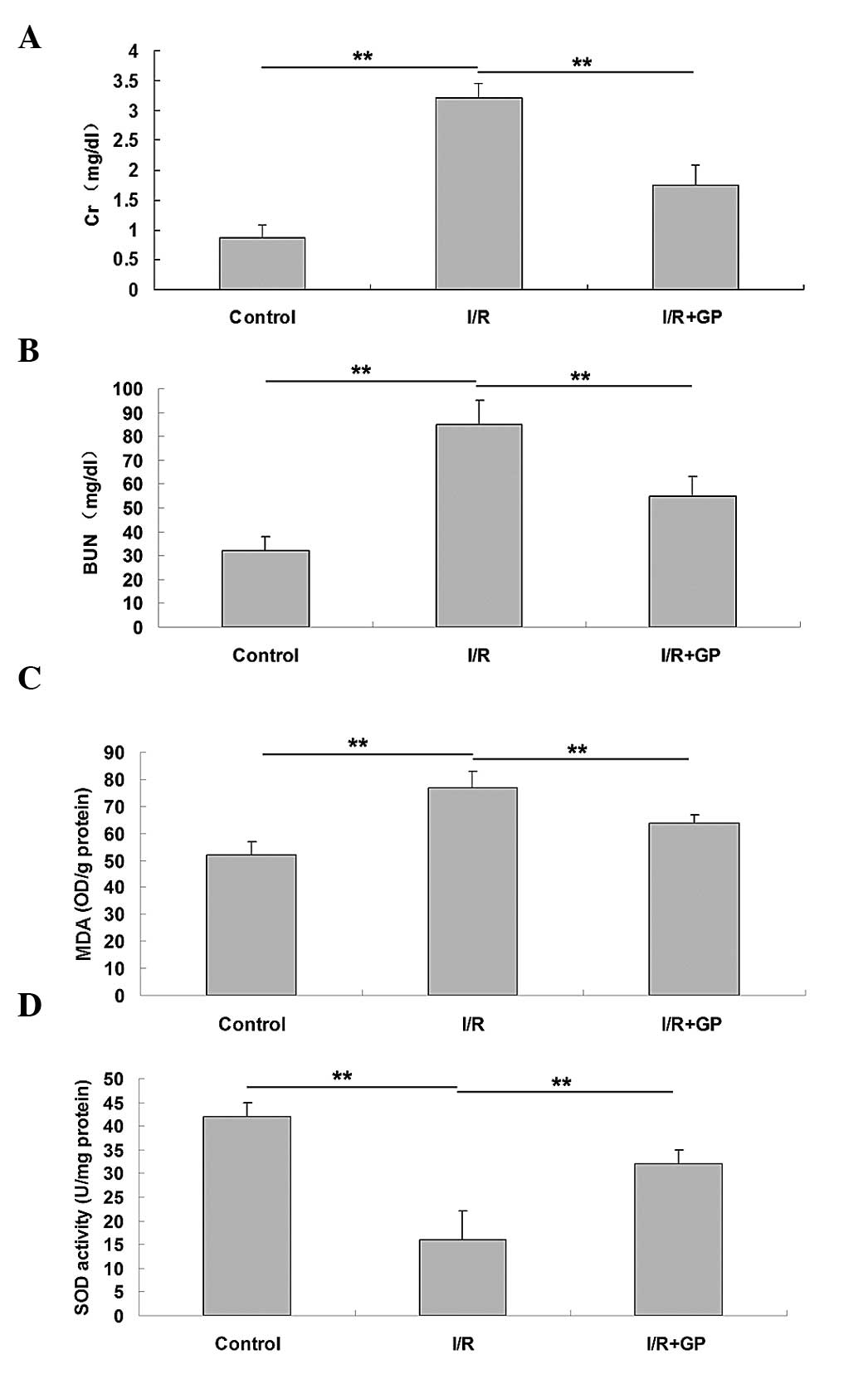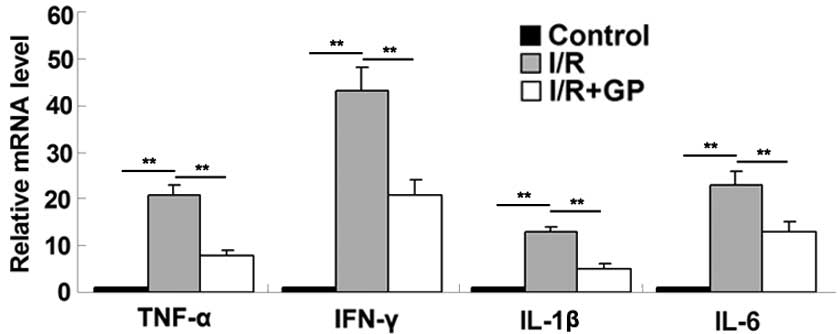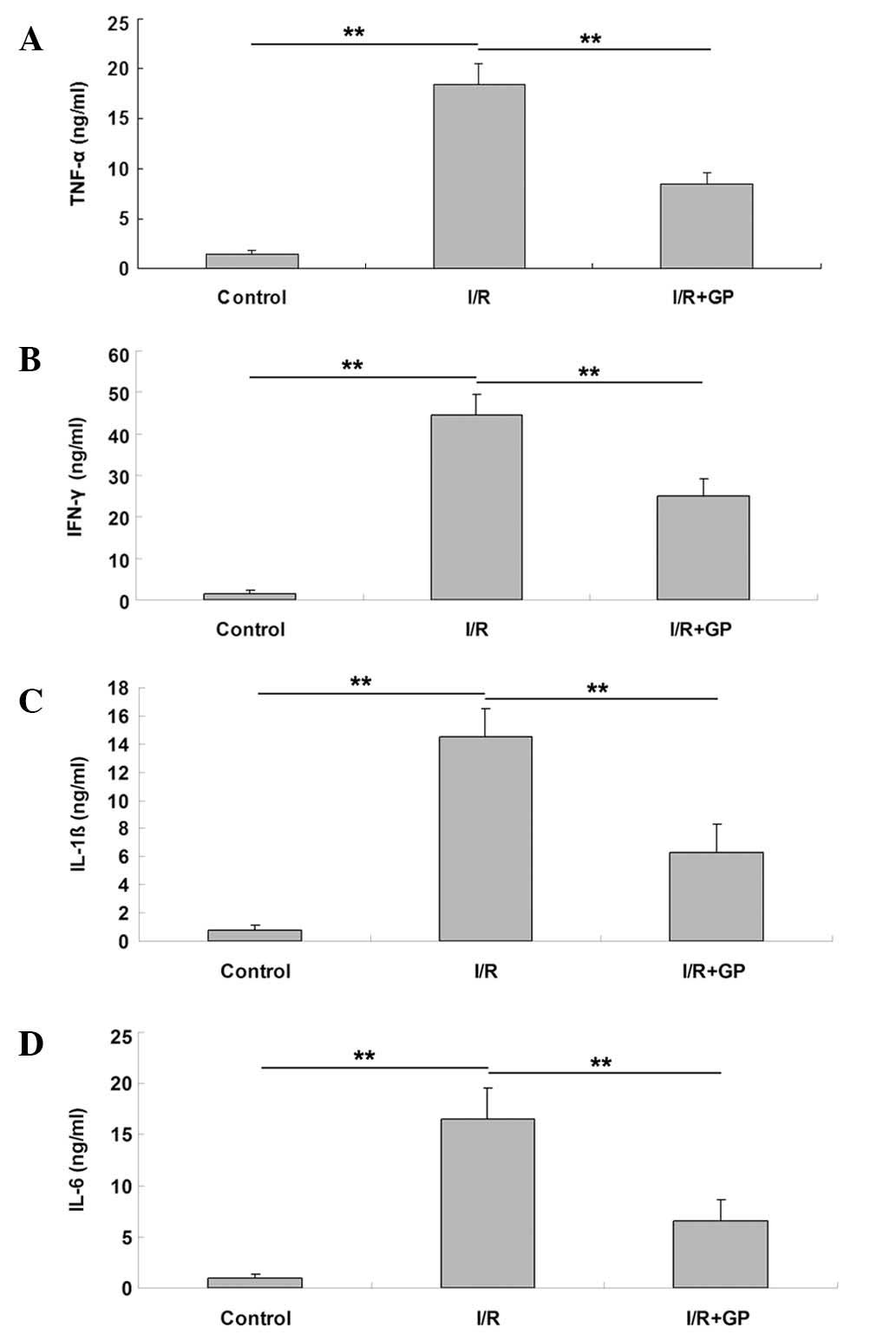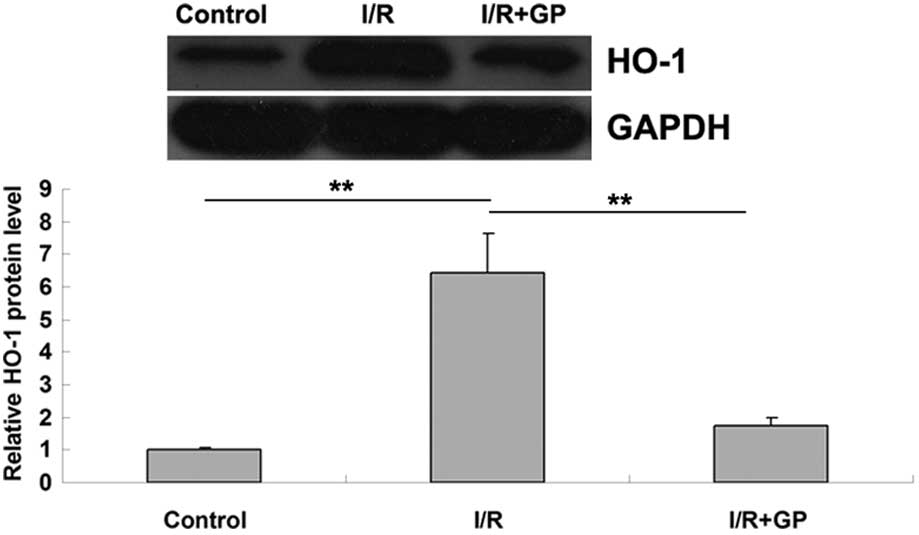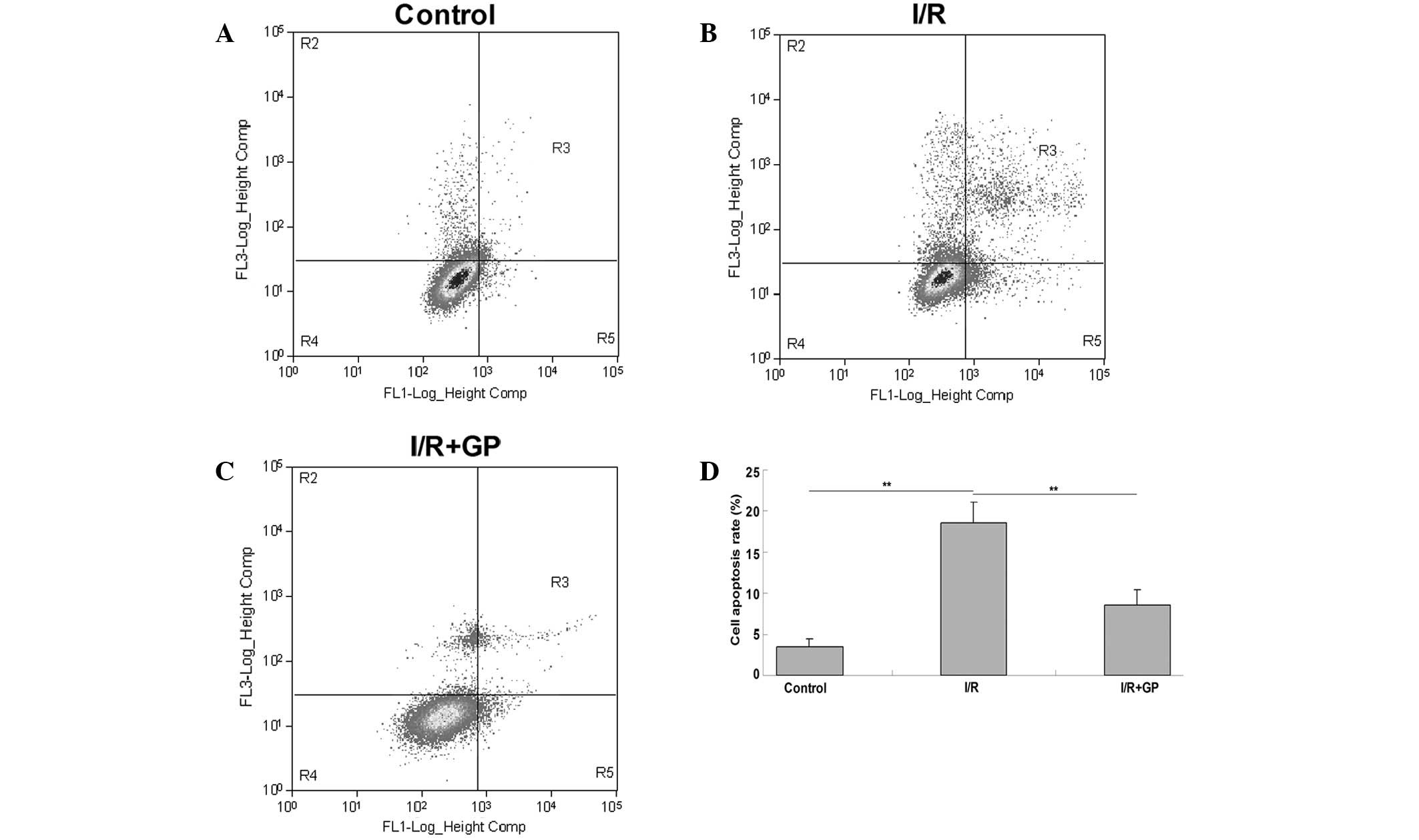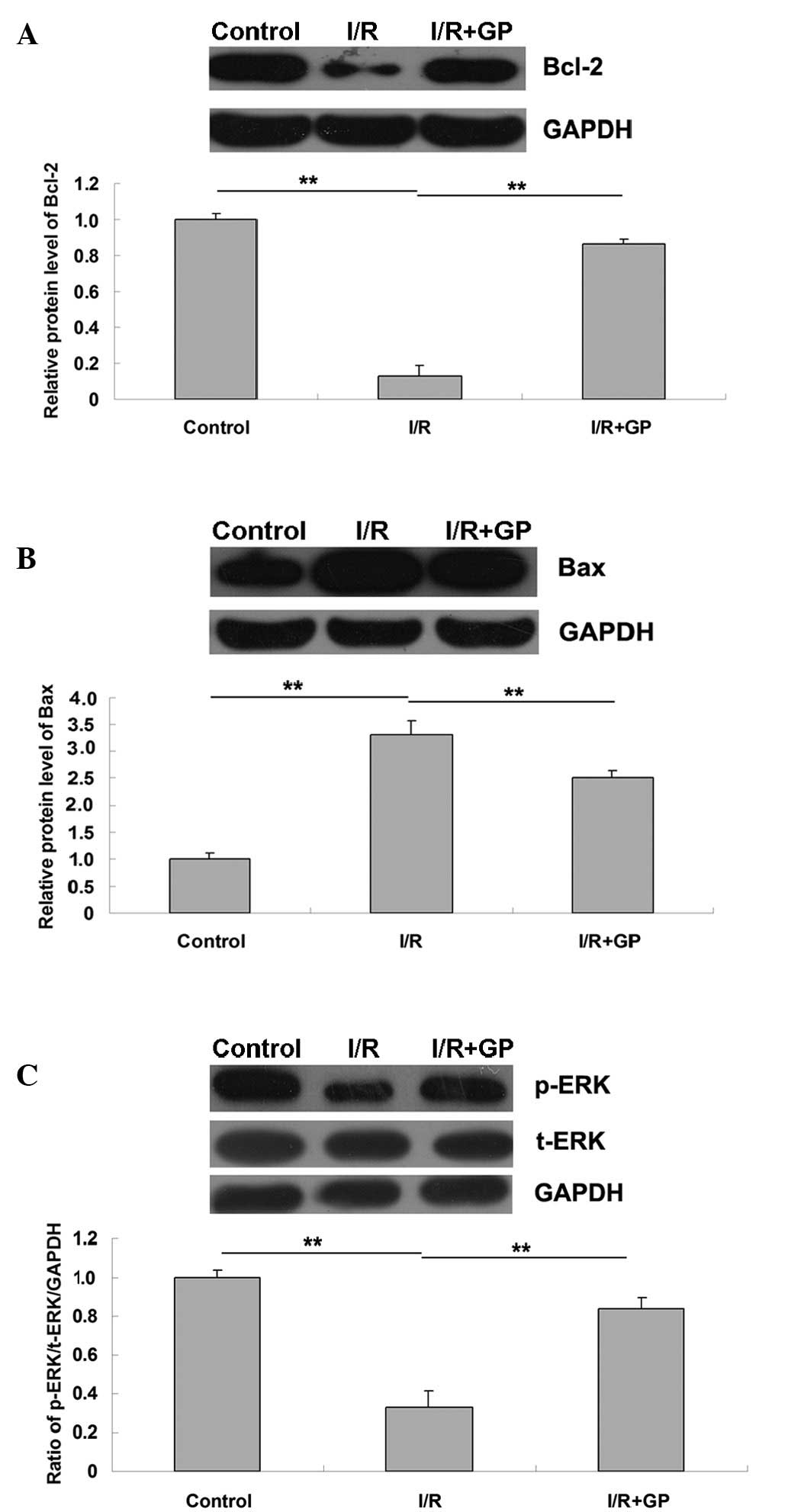|
1
|
Zhou M, Tang W, Fu Y, Xu X, Wang Z, Lu Y,
Liu F, Yang X, Wei X, Zhang, Y, et al: Progranulin protects against
renal ischemia/reperfusion injury in mice. Kidney Int. 87:918–929.
2015. View Article : Google Scholar : PubMed/NCBI
|
|
2
|
Menke J, Sollinger D, Schamberger B,
Heemann U and Lutz J: The effect of ischemia/reperfusion on the
kidney graft. Curr Opin Organ Transplant. 19:395–400. 2014.
View Article : Google Scholar : PubMed/NCBI
|
|
3
|
Kaczorowski DJ, Tsung A and Billiar TR:
Innate immune mechanisms in ischemia/reperfusion. Front Biosci
(Elite Ed). 1:91–98. 2009.PubMed/NCBI
|
|
4
|
Quan Y, Yang Y, Wang H, Shu B, Gong QH and
Qian M: Gypenosides attenuate cholesterol-induced DNA damage by
inhibiting the production of reactive oxygen species in human
umbilical vein endothelial cells. Mol Med Rep. 11:2845–2851.
2015.PubMed/NCBI
|
|
5
|
Deng Q and Yang X: Protective effects of
Gynostemma pentaphyllum polysaccharides on PC12 cells
impaired by MPP(+). Int J Biol Macromol. 69:171–175. 2014.
View Article : Google Scholar : PubMed/NCBI
|
|
6
|
Li K, Du Y, Fan Q, Tang CY and He JF:
Gypenosides might have neuroprotective and immunomodulatory effects
on optic neuritis. Med Hypotheses. 82:636–638. 2014. View Article : Google Scholar : PubMed/NCBI
|
|
7
|
Yan H, Wang X, Niu J, Wang Y, Wang P and
Liu Q: Anti-cancer effect and the underlying mechanisms of
gypenosides on human colorectal cancer SW-480 cells. PLoS One.
9:e956092014. View Article : Google Scholar : PubMed/NCBI
|
|
8
|
Quan Y and Qian MZ: Effect and mechanism
of gypenoside on the inflammatory molecular expression in high-fat
induced atherosclerosis rats. Zhong Guo Zhong Xi Yi Jie He Za Zhi.
30:403–406. 2010.(In Chinese).
|
|
9
|
Qi G, Zhang L, Xie WL, Chen XY and Li JS:
Protective effect of gypenosides on DNA and RNA of rat neurons in
cerebral ischemia-reperfusion injury. Acta Pharmacol Sin.
21:1193–1196. 2000.PubMed/NCBI
|
|
10
|
Zhang Y, Zhang JE, Xiao HQ, Wu PY and Bai
SJ: Gypenosides inhibit renal fibrosis by regulating expression of
related genes in rats with unilateral ureteral obstruction. J
Nephrol. 24:112–118. 2011. View Article : Google Scholar : PubMed/NCBI
|
|
11
|
Qin R, Zhang J, Li C, Zhang X, Xiong A,
Huang F, Yin Z, Li K, Qin W, Chen M, et al: Protective effects of
gypenosides against fatty liver disease induced by high fat and
cholesterol diet and alcohol in rats. Arch Pharm Res. 35:1241–1250.
2012. View Article : Google Scholar : PubMed/NCBI
|
|
12
|
Zhao J, Ming Y, Wan Q, Ye S, Xie S, Zhu Y,
Wang Y, Zhong Z, Li L and Ye Q: Gypenoside attenuates hepatic
ischemia/reperfusion injury in mice via anti-oxidative and
anti-apoptotic bioactivities. Exp Ther Med. 7:1388–1392.
2014.PubMed/NCBI
|
|
13
|
Daemen MA, de Vries B and Buurman WA:
Apoptosis and inflammation in renal reperfusion injury.
Transplantation. 73:1693–1700. 2002. View Article : Google Scholar : PubMed/NCBI
|
|
14
|
Cao XZ, Ma H, Wang JK, Liu F, Wu BY, Tian
AY, Wang LL and Tan WF: Postoperative cognitive deficits and
neuroinflammation in the hippocampus triggered by surgical trauma
are exacerbated in aged rats. Prog Neuropsychopharmacol Biol
Psychiatry. 34:1426–1432. 2010. View Article : Google Scholar : PubMed/NCBI
|
|
15
|
Facio FN Jr, Sena AA, Araújo LP, Mendes
GE, Castro I, Luz MA, Yu L, Oliani SM and Burdmann EA: Annexin 1
mimetic peptide protects against renal ischemia/reperfusion injury
in rats. J Mol Med (Berl). 89:51–63. 2011. View Article : Google Scholar : PubMed/NCBI
|
|
16
|
Zhu J, Chen X, Wang H and Yan Q: Catalpol
protects mice against renal ischemia/reperfusion injury via
suppressing PI3K/Akt-eNOS signaling and inflammation. Int J Clin
Exp Med. 8:2038–2044. 2015.PubMed/NCBI
|
|
17
|
Esterbauer H and Cheeseman KH:
Determination of aldehydic lipid peroxidation products:
Malonaldehyde and 4-hydroxynonenal. Methods Enzymol. 186:407–421.
1990. View Article : Google Scholar : PubMed/NCBI
|
|
18
|
Livak KJ and Schmittgen TD: Analysis of
relative gene expression data using real-time quantitative PCR and
the 2(−Delta Delta C(T)) Method. Methods. 25:402–408. 2001.
View Article : Google Scholar : PubMed/NCBI
|
|
19
|
Sass G, Barikbin R and Tiegs G: The
multiple functions of heme oxygenase-1 in the liver. Z
Gastroenterol. 50:34–40. 2012. View Article : Google Scholar : PubMed/NCBI
|
|
20
|
Chen JC, Tsai CC, Chen LD, Chen HH and
Wang WC: Therapeutic effect of gypenoside on chronic liver injury
and fibrosis induced by CCl4 in rats. Am J Chin Med. 28:175–185.
2000. View Article : Google Scholar : PubMed/NCBI
|
|
21
|
El Morsy EM, Ahmed MA and Ahmed AA:
Attenuation of renal ischemia/reperfusion injury by açaí extract
preconditioning in a rat model. Life Sci. 123:35–42. 2014.
View Article : Google Scholar : PubMed/NCBI
|
|
22
|
Ysebaert DK, De Greef KE, Vercauteren SR,
Ghielli M, Verpooten GA, Eyskens EJ and De Broe ME: Identification
and kinetics of leukocytes after severe ischaemia/reperfusion renal
injury. Nephrol Dial Transplant. 15:1562–1574. 2000. View Article : Google Scholar : PubMed/NCBI
|
|
23
|
Contaldo C, Meier C, Elsherbiny A, Harder
Y, Trentz O, Menger MD and Wanner GA: Human recombinant
erythropoietin protects the striated muscle microcirculation of the
dorsal skinfold from postischemic injury in mice. Am J Physiol
Heart Circ Physiol. 293:H274–H283. 2007. View Article : Google Scholar : PubMed/NCBI
|
|
24
|
Domański L, Pawlik A, Safranow K, Rozański
J, Myślak M, Sulikowski T, Romanowski M, Ostrowski M, Wiśniewska M,
Domański M, et al: Changes in cytokine concentrations in graft
renal vein during reperfusion in patients with and without delayed
graft function. Ann Acad Med Stetin. 54:49–52. 2008.PubMed/NCBI
|
|
25
|
Akl H, Vervloessem T, Kiviluoto S,
Bittremieux M, Parys JB, De Smedt H and Bultynck G: A dual role for
the anti-apoptotic Bcl-2 protein in cancer: Mitochondria versus
endoplasmic reticulum. Biochim Biophys Acta. 1843:2240–2252. 2014.
View Article : Google Scholar : PubMed/NCBI
|
|
26
|
Anilkumar U and Prehn JH: Anti-apoptotic
BCL-2 family proteins in acute neural injury. Front Cell Neurosci.
8:2812014. View Article : Google Scholar : PubMed/NCBI
|
|
27
|
Saitoh Y, Ouchida R, Kayasuga A and Miwa
N: Anti-apoptotic defense of bcl-2 gene against
hydroperoxide-induced cytotoxicity together with suppressed lipid
peroxidation, enhanced ascorbate uptake, and upregulated Bcl-2
protein. J Cell Biochem. 89:321–334. 2003. View Article : Google Scholar : PubMed/NCBI
|
|
28
|
Renault TT and Chipuk JE: Death upon a
kiss: Mitochondrial outer membrane composition and organelle
communication govern sensitivity to BAK/BAX-dependent apoptosis.
Chem Biol. 21:114–123. 2014. View Article : Google Scholar : PubMed/NCBI
|
|
29
|
Renault TT, Teijido O, Antonsson B, Dejean
LM and Manon S: Regulation of Bax mitochondrial localization by
Bcl-2 and Bcl-x(L): Keep your friends close but your enemies
closer. Int J Biochem Cell Biol. 45:64–67. 2013. View Article : Google Scholar : PubMed/NCBI
|
|
30
|
Jiang M, Li J, Peng Q, Liu Y, Liu W, Luo
C, Peng J, Li J, Yung KK and Mo Z: Neuroprotective effects of
bilobalide on cerebral ischemia and reperfusion injury are
associated with inhibition of pro-inflammatory mediator production
and down-regulation of JNK1/2 and p38 MAPK activation. J
Neuroinflammation. 11:1672014. View Article : Google Scholar : PubMed/NCBI
|
|
31
|
Jun JH, Jun NH, Shim JK, Shin EJ and Kwak
YL: Erythropoietin protects myocardium against ischemia-reperfusion
injury under moderate hyperglycemia. Eur J Pharmacol. 745:1–9.
2014. View Article : Google Scholar : PubMed/NCBI
|
|
32
|
Ottani A, Galantucci M, Ardimento E, Neri
L, Canalini F, Calevro A, Zaffe D, Novellino E, Grieco P, Giuliani
D and Guarini S: Modulation of the JAK/ERK/STAT signaling in
melanocortin-induced inhibition of local and systemic responses to
myocardial ischemia/reperfusion. Pharmacol Res. 72:1–8. 2013.
View Article : Google Scholar : PubMed/NCBI
|
|
33
|
Wu X, Xu T, Li D, Zhu S, Chen Q, Hu W, Pan
D, Zhu H and Sun H: ERK/PP1a/PLB/SERCA2a and JNK pathways are
involved in luteolin-mediated protection of rat hearts and
cardiomyocytes following ischemia/reperfusion. PLoS One.
8:e829572013. View Article : Google Scholar : PubMed/NCBI
|
|
34
|
Ban K, Peng Z and Kozar RA: Inhibition of
ERK1/2 worsens intestinal ischemia/reperfusion injury. PLoS One.
8:e767902013. View Article : Google Scholar : PubMed/NCBI
|
|
35
|
Yang Y, Zhang X, Cui H, Zhang C, Zhu C and
Li L: Apelin-13 protects the brain against ischemia/reperfusion
injury through activating PI3K/Akt and ERK1/2 signaling pathways.
Neurosci Lett. 568:44–49. 2014. View Article : Google Scholar : PubMed/NCBI
|
|
36
|
Wang QY, Liu F, Wu FJ and Li JL: Effects
of ginsenoside Rg1 on the expressions of p-eRK1/2 and p-JNK in
local cerebral ischemia/reperfusion injury rats. Zhong Guo Zhong Xi
Yi Jie He Za Zhi. 33:229–234. 2013.(In Chinese).
|















